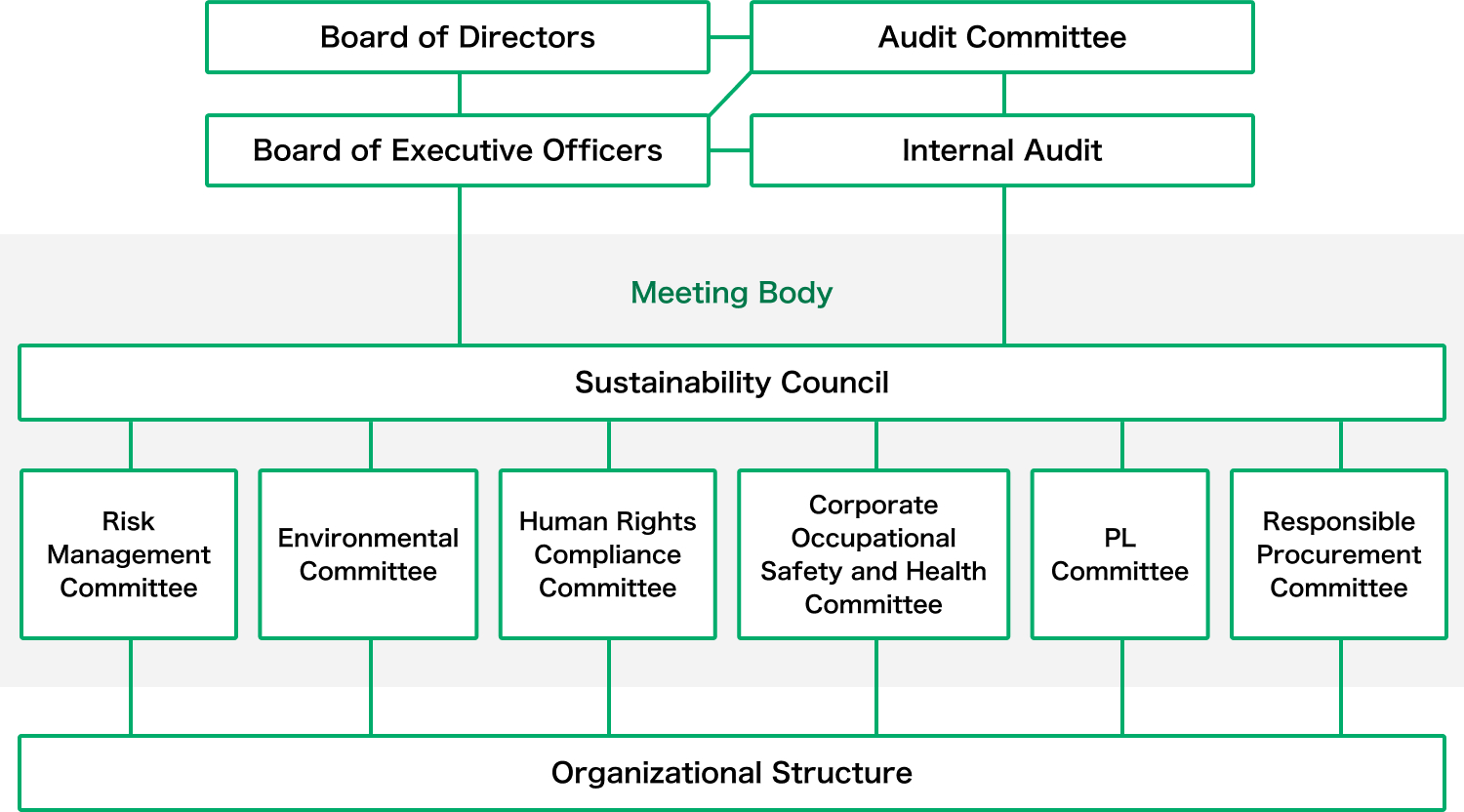Risk Management
Approach to Risk Management
In addition to proactively minimizing the numerous management risks
that surround the company, our corporate group implements
comprehensive risk management to reduce damage in the case of an
occurrence. In recent years, social demands for sustainability have
increased, and the management risks faced by companies have further
increased. Against this backdrop, our corporate group aims to
achieve sustainable growth and enhance corporate value by
appropriately managing these risks.
We have developed a robust risk management system to identify risks
that impact our business and implement appropriate countermeasures
and management.
Risk Management System
We have established a "Sustainability Council" as part of the
group's risk management structure to discuss sustainability-related
risks and opportunities. Under this council, there are the Risk
Management Committee, Environment Committee, Human Rights and
Compliance Committee, Occupational Health and Safety Committee,
Quality Assurance Committee, and Responsible Procurement Committee,
each of which is responsible for specific risks.
The role of the Sustainability Council is chaired by the President
and CEO, who serves as the chairman and manages all risks as the
chief risk officer. Executive officers serve as members, and the
executive officers in charge appropriately respond according to the
characteristics of the risks.
The Corporate Planning Department is in charge of the secretariat,
overseeing the committee's operations and providing support.
Sustainability meetings are held on a quarterly basis, with the
chairman reporting deliberated matters to the board of directors.
The chairman provides the executive officer in charge with
recommendations and proposals as needed. This strict system ensures
early detection of risks and appropriate responses.
【Risk Management System】

Objectives of Each Committee
The Sustainability Council controls each committee and manages risks
for the entire group in an integrated manner. Key risks include
those related to overall corporate activities, financial activities,
human rights and occupational health and safety, information storage
management and information system-related activities, sales
activities, the environment, purchasing activities, and the supply
chain.
The Risk Management Committee conducts risk assessments and
develops, implements, and continuously monitors response plans in
addition to implementing ERM across the entire Furthermore, the
Environmental Committee formulates prioritized targets and action
plans addressing risks related to the global environment, such as
climate change, and regularly reviews and improves the plans.
In 2024, third-party CSR audits based on international standards
were conducted at our factories in Japan. Through these audits, we
identified specific risks that must be addressed in order to fulfill
our corporate social responsibility. Based on the results of these
audits, we will implement corrective measures.
Based on company-wide ERM and CSR audits, we are implementing
measures to (1) develop and strengthen our environmental management
and (2) develop and strengthen our human resources strategies as
particularly important issues in order to prevent risks and build a
foundation for fulfilling our responsibilities as a company.
Production of a Business Continuity Plan (BCP)
As part of the group's Business Continuity Plan (BCP), an action plan is being developed for use in the event of a disaster or other emergency. Risk management involves four processes: "risk identification," "analysis and assessment," "response and countermeasures," and "response monitoring and improvement." Through these processes, we strengthen our system to minimize the impact of risks and continue business activities. We consider BCP, which includes preparations for various risks such as natural disasters, social turmoil, and pandemics, to be an important element for enhancing corporate resilience.
Administrative Order based on the Act Against Unjustifiable Premiums and Misleading Representations
On April 25, 2024, our company received an administrative order from
the Consumer Affairs Agency pursuant to Article 7, Paragraph 1 of
the Act against Unjustifiable Premiums and Misleading
Representations with respect to "MoriLabo Pollen Barrier Stick,"
"MoriLabo Pollen Barrier Seal," "MoriLabo Pollen Barrier Spray," and
"MoriLabo Night Care Pollen Barrier Pot." In response, our corporate
group has completed all measures related to the order and is working
on measures to prevent recurrence. Specifically, we are reviewing
our internal processes and working on measures to ensure appropriate
labeling and accurate information provision to customers.
Our group will continue to make efforts to flexibly respond to
changes in the business environment through risk management and
realize sustainable corporate activities. We will continue to raise
awareness of sustainability and strengthen our risk management
system in cooperation with internal and external stakeholders to
appropriately manage risks, enhance corporate sustainability, and
fulfill our social responsibilities.
Our Impact